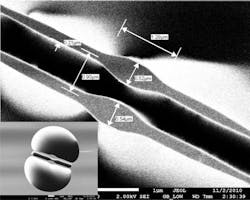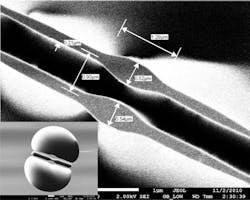Dual-core optical fiber could enhance data processing
Optical fibers carry movies, messages, and music at the speed of light, but switching, routing, and buffering of data mostly rely on the use of relatively slow electronic components. Hoping to do away with these information speed bumps, a team of researchers has developed an elegant dual-core optical fiber that can perform the same functions just by applying a miniscule amount of mechanical pressure.
The new nanomechanical fibers could greatly enhance data processing and also serve as sensors in electronic devices, say researchers at the University of Southampton in the UK. The work is described in the Optical Society of America’s open-access journal Optics Express, Vol. 20, Issue 28, pp. 29386-29394 (2012).
“Nanomechanical optical fibers do not just transmit light like previous optical fibers,” said Wei H. Loh, deputy director of the EPSRC Centre for Innovative Manufacturing in Photonics and researcher at the Optoelectronics Research Centre, both at the University of Southampton. “Their internal core structure is designed to be dynamic and capable of precise mechanical motion. This mechanical motion, created by applying a tiny bit of pressure, can harness some of the fundamental properties of light to give the fiber new functions and capabilities.”
The cores in the optical fiber are close enough to each other (less than 1 micron) to be optically coupled – a photon traveling down one core is physically affected by the presence of the nearby second core. By shifting the position of one of the cores by just a few nanometers, the researchers changed how strongly the light responded to this coupling effect. If the coupling effect is strong enough, the light immediately jumps from one fiber to the other.
“Think of having a train traveling down a two-track tunnel and jumping the tracks and continuing along its way at the same speed,” explained Loh. The flexible suspension system of the fiber easily responds to the slightest bit of pressure, the researchers assert, bringing the two cores closer together or moving them apart, thereby controlling when and how the signals hop from one core to the other. The result is reproducing, for the first time, the function of an optical switch inside the actual fiber.
This same capability may also enable optical buffering, which has been very hard to achieve, according to the researchers. “With our nanomechanical fiber structure, we can control the propagation time of light through the fiber by moving the two cores closer together, thereby delaying, or buffering, the data as light,” said Loh. Buffers are essential when multiple data streams arrive at a router at the same time; they delay one stream so another can travel freely.
To create the new fibers, the researchers heated and stretched a specially shaped tube of optical glass with a hollow center containing two cores suspended from the inside wall (see image, courtesy of the University of Southampton). The fibers maintain this delicate structure as they are drawn and stretched to the desired thickness.
According to the researchers, this is the first time that nanomechanical dual-core fibers have been fabricated directly. Other types of multicore fibers have been fabricated previously, but their cores are encased in glass and therefore are mechanically locked.
“An implication of our work is that we would integrate more of these functions within the fiber backbone,” says Loh, “through the introduction of MEMS [micro-electro-mechanical systems] functionality in the fibers.”
Loh and his colleagues also expect this introduction of MEMS functionality into the optical fiber to have implications in other fields, such as sensing. “Nanomechanical fibers could one day take the place of silicon-based MEMS chips, which are used in automobile sensors, video game controllers, projection displays, and other every-day applications,” observes Loh. Because the fibers are so sensitive to pressure and can be readily drawn to very long lengths, they also could be integrated into bridges, dams, and other buildings to signal subtle changes that could indicate structural damage.
The next step of their research is to test the fibers at longer lengths and to enhance the precision with which they perform switching and other functions. The researchers hope that nanomechanical fibers could reach the market within the next three to five years.
For more information on optical components and suppliers, visit the Lightwave Buyers Guide.

